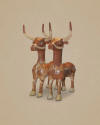Sivas
Situated at an altitude of 1275 m, Sivas is the
highest city of the Central Anatolian Region, and the most mountainous one with
numerous peaks. This uneven land has been the shelter of many tribes from the
earliest ages to more recent periods from which remain many notable monuments.
Sivas, being at the junction point of the Persia
and Baghdad caravan routes, was once a busy commercial center. During the
interval between 1142 and 1171, it was the capital of the Turkish Danismend
Emirs. Later, under the rule of the Seljuks, it became a cultural center with
importance given to learning and scholarship. Many related buildings were
constructed, the remains of some can still be seen today.
One of the outstanding numerous Seljuk works of
art and architecture is Izzeddin Keykavus Sifahanesi which was "a house of
recovery" in those times, in other words "a hospital". It was built in 1217 by
the order of the Seljuk Sultan, and its decoration with painted tiles is
beautiful.
Gok Medresse and Buruciye Medresse, both built in
1271, constitute the best examples of wonderful Seljuk artistic works, while the
Ulu Mosque of the Danismend Emirate is another fine historical monument,
reflecting a different style. The Cifte Minareli Medresse of the same year, is
also noteworthy with its twin minarets rising elegantly on both sides of its
ornate portal.
Throughout the long history of the city, the role
played by Sivas during the War of Independence is important in that the National
Congress took the decision to fight for the liberalization of Turkey here in
1919. The school building used then is now the Ataturk and Congress Museum with
the relevant documents of the congress and war are on display, together with
ethnographical finds and local handicrafts.
165 kms southeast of Sivas is the ancient town of
Divrigi, which was once a Byzantine site. By the 12th and 13th centuries, it was
the capital of Turkish Mengucek Emirs, and the remains of Ulu Mosque of 1229 and
a citadel remain from that period. The Baroque style portal of this magnificent
mosque is a real masterpiece of stonework, and this monumental building has been
declared by UNESCO to be one of the eminent cultural heritages of the world.
Besides its historical treasures, the city
possesses several other specialties, one of which is Balikli Kaplica, an
interesting spa of the town of Kangal. It is a thermal spring, filled with tiny
fish living in the hot waters, which provides a different type of cure for skin
complaints. It is the only cure center in the world for "Sedef Hastaligi"
(psoriasis). Soguk Cermik is another spa center. Hafik, Todurge (Zara), and
Gokpinar (Gurun) Lakes are the interesting places for picnicking, boating and
fishing. Another special characteristic of this town, 68 kms south of Sivas, are
the world famous Kangal dogs. These sheep dogs have proven their loyalty, and
success and are confidently used in the area of police work.
Sivas is also known for its fine carpets of
various designs and colors. These locally produced weavings offer a wide variety
of choice, and the inherent high quality is not subject to variation.

Timeline of Sivas
In Central-Eastern
Turkey. A Ghazi state during the Middle Ages, a major rival to the Seljuqs for a
time.
- To the Roman
Republic...............................70-27
- To the Roman Empire.............................27 BCE-395 CE
- To the Byzantine Empire............................395-1071
- DANISHMENDID
- Danishmend........................................1071-1084
- Gumushtigin.......................................1084-1134
- Muhammad Nasr ad-Din..............................1134-1142
- Dhul-Nun...............................................1142 d.
1173
- Yaghi-Basan.......................................1142-1164
- Ismail............................................1164-1166
- Ismail Shams ad-Din...............................1166-1168
- Dhul-Nun (restored)...............................1168-1173
- To the Rum Seljuqs................................1173-1243
- To the Persian
Il-Khans...........................1243-1336
- To Kayseri........................................1336-1380
- QADI BURHAN
- Qadi Burhan ad-Din Ahmad..........................1380-1398
- Aladdin 'Ali Zayn al-Abadin............................1398
- To the Ottoman Empire, 1398...

-
TransAnatolie Tour
- A - Group
License N°4938 - The Turkish Ministry of Culture and Tourism
-
|




